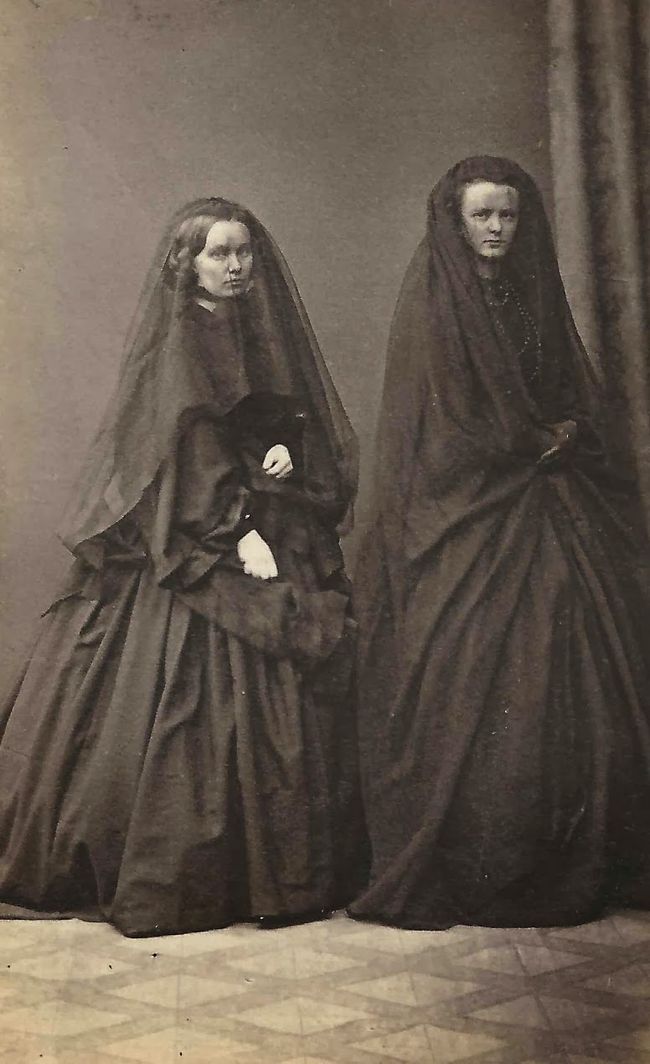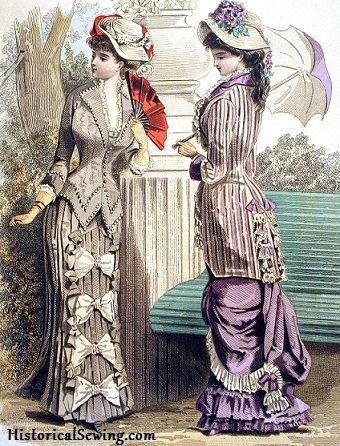1880 -1888
THE RISE AND FALL OF THE BUSTLE
By 1880 there was no discernible bustle, and fishtail trains were rejected.
Cotton combinations — chemise and drawers — were worn under the main outfit, and were supplemented by knit wool combination garments that combated a series of cold winters.
An extremely tight, steel-boned corset secured the small waist that was being increasingly admired and forced a rigid, upright posture.
A new bustle shape gradually developed from 1881-83, this time stiff and angular.
From 1883-87 the bustle grew, and stuck out at right angles, eventually tilting over into a chicken tail feather flourish before disappearing.
The majority of garments were now made by sewing machine, and many fabrics were colored with synthetic dyes.
MOURNING
There was a strict etiquette for mourning royalty and relatives.
The fashion industry perfected the art of dyeing fabric black, providing copious lengths of black crepe and bombazine fabrics, ribbons, bonnets, veils, and feathers.
Department stores stocked ready-to-wear mourning outfits.
FANS
Fans were produced in huge numbers.
They were the perfect gift — as was Lady Windermere’s fan in the 1892 Oscar Wilde play of the same name — and useful in a warm ballroom or theater.
The early 18th century language of the fan was largely lost by the late 19th century, but might at least allow a female to signal interest or otherwise to a gentleman admirer.
1880 - 1888
臀衬的崛起与陨落
1880年臀衬的识别度还没有很高,鱼尾长下摆是被大众拒绝的。
棉织物组合,包括衬衣与多层蛋糕花边,都穿在主要外套里面,并辅以羊毛针织服装作为补充,抵御了一系列寒冷的冬天。
一种非常紧身的,钢骨胸衣巩固了窄小的腰围而越来越受到人们的青睐,人们被迫保持直立的姿势。一种新的臀衬形状逐渐从1881-83年发展起来,这段时期是僵硬与有棱角的。
1883-87年,臀衬发展起来,并延展出了直线角度,最终蓬勃发展成倾斜的鸡尾造型,直至消失。
到了这个时期,大多数服装都由缝纫机制成了,并且许多面料都以合成染料染色。
丧服
皇室与其亲眷的哀悼都要遵循非常严格的礼仪。
服装行业完善了黑色织物的染色艺术,并且提供了大量黑色绉纱和棉纱面料,还有丝带,帽子,面纱与羽毛。
百货公司会备存哀悼服装的成品。
扇子
扇子被大量制造。
它们是完美的礼物 — 就像温德米尔夫人在1892年奥斯卡王尔德的同名演出中表演的角色那样使用,并且它们在温暖的舞厅或剧院中都很有用。
十八世纪早期扇子的表达很大程度上在十九世纪后期消失了,但至少还能利用扇子体现一位女性向一位绅士仰慕者表示感兴趣的寓意。







